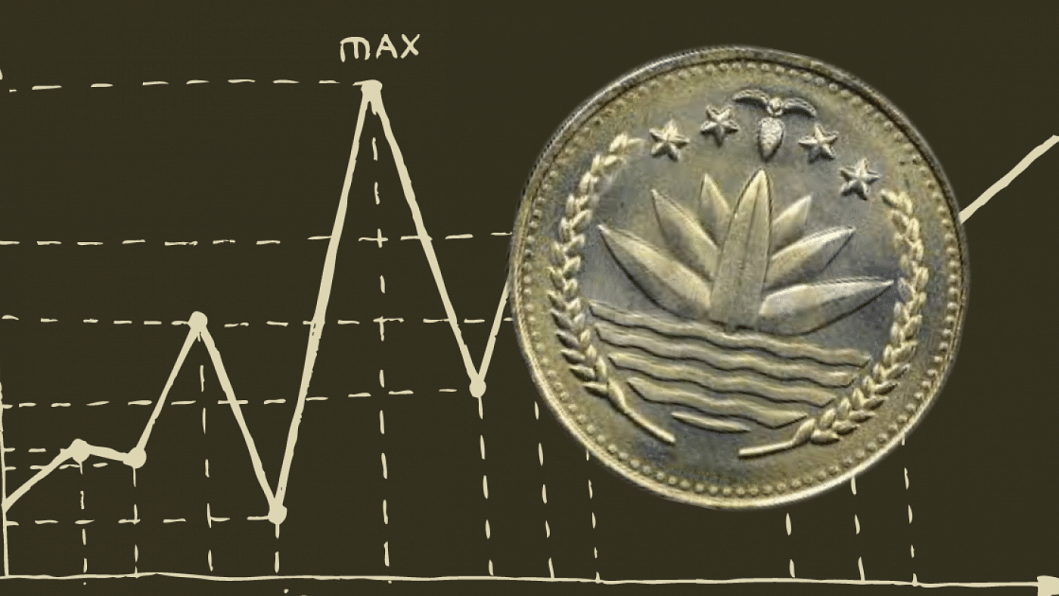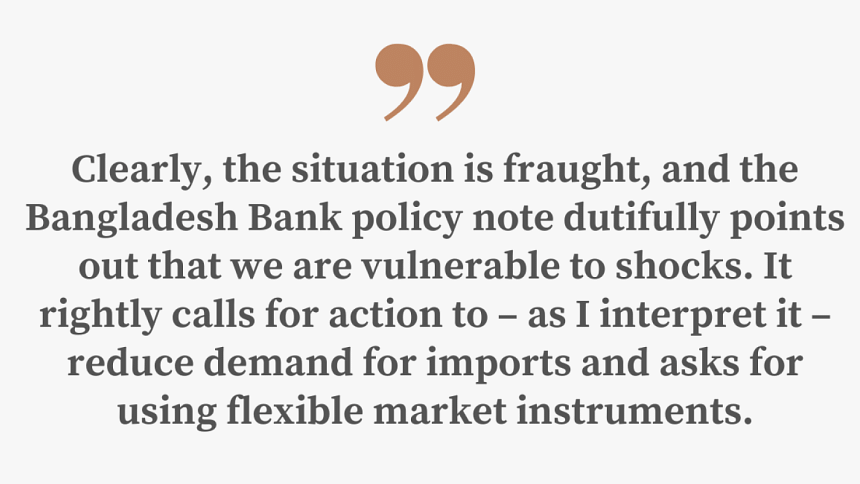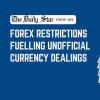Is Bangladesh Bank finally ready to tackle the external deficit?

Two weeks ago, a Bangladesh Bank policy note provided a timely alert on the current macroeconomic situation. Titled, "Impact of exchange rate and global commodity price inflation on private sector credit," it was written by the bank's chief economist, Dr Habibur Rahman, and two of his colleagues, while guidance of the bank's governor was acknowledged. Although the bank clarified that the document was not its official stance, it is fair to assume it expresses the Bank leadership's evolving thinking.
Ostensibly, the main point is that the marked uptick in credit growth to the private sector should not be seen as excessive or inflationary. Rather, after adjusting for the high commodity inflation and exchange rate depreciation, real private sector credit growth is much less. The export-import credit growth turned negative in dollar terms last September and October. The note also suggests that the combination of global commodity price inflation and exchange rate depreciation has mainly been driving private credit growth.
So far, so good. The main point is factually correct, and the last point is reasonable even if not conclusively made. But if all this seems a bit academic, that is not the case.
As this newspaper highlighted last week in a report titled, "Only two options left for Macroeconomic Stability," the concluding section of the note has quite dramatic policy relevance. Three significant macroeconomic management challenges for Bangladesh are presented here. One, the combination of global commodity inflation and exchange rate depreciation creates an asymmetrical impact on trade finance that, as I interpret, surges import payments relative to export receipts. That creates a "liquidity mismatch" for banks: advances are growing faster than deposits.
Second, this exchange rate depreciation adversely affects private firms' and governments' ability to make debt payments as they become larger in terms of the taka. These pending debt payments and international commodity import prices – payable in dollars – also lead to a currency mismatch and put pressure on foreign exchange reserves. Third, it notes, quite rightly, the continued risks of global commodity price increases and imported inflation will affect the budgets of firms and the government, requiring belt-tightening.
So, what is to be done? The note concludes, with some former US Fed Chair Alan Greenspan-style ambiguity, that "there are not many policy options available other than making appropriate supply-side interventions, while managing the exchange rate adversities requires market-oriented flexibility."
I have two reactions to this note. First, I welcome the seriousness with which the current situation is addressed. It is a departure from the "don't worry, be happy" style wishful thinking that we sometimes see: the problem is being solved, and good days are coming.

That is likely not the case, and the policy note has done a service by alerting us to this. Consider that in the first four months of the current fiscal year, we have imported over USD 27 billion of goods and run a trade deficit of USD 10.7 billion. While our exports crossed USD 5 billion in November, the Bangladesh Bank website has not provided import figures. On the overall current account side, our deficit is USD 3.7 billion over the same period. Beyond financing these deficits, we have also had to make debt payments. Altogether, our foreign exchange reserves have declined by another USD 8 billion in the first five months of this fiscal year. That places our reserve import cover at less than four months if we use the IMF's definition or five months if we use the government's definition.
Clearly, the situation is fraught, and the Bangladesh Bank policy note dutifully points out that we are vulnerable to shocks. It rightly calls for action to – as I interpret it – reduce demand for imports and asks for using flexible market instruments.
That leads me to my second point. The note is not explicit enough. It indeed refers to the need for exchange rate flexibility, which is already partially in place. It may also be asking for interest rate flexibility. If not so, why this note? If so, one wishes it was more explicit.
The reality is that using only the exchange rates without interest rate action will deepen the crisis. Bangladesh Bank has increased its overnight lending (repo) rate a few times to 5.75 percent. But oblivious to exchange rate movements and liquidity needs, it has held fast its main policy rate of lending to banks at four percent throughout this crisis, and commercial bank lending rates have also been stuck at just over seven percent. We know these long unchanged rates are below market rates because the more market-based call money interest rates have doubled since last December.
Furthermore, banks' saving and lending interest rates are lower than inflation rates, or negative in real terms. If this continues, it will benefit both consumers and firms to borrow money and spend now, especially on imports, and repay later – or not – if they are well connected.
There are five ways these negative real interest rates are hurting the economy. First, as just noted, there is no reason for either consumers or investors to reduce demand for credit and spending at these rates. The fundamental reason for having a current account deficit is to spend more than what we earn. Not adjusting interest rates is, thus, an assured way to deepen our reserves problem.
Second, suppressing interest rates means a wealth transfer by taxing the primarily middle-class savers to the mostly wealthy borrowers who get subsidised credit. Further, credit will have to be rationed at below-market rates because there will be excess demand. It is likely that, favoured borrowers, many of whom have already caused the economy a lot of pain, will gain again.
Third, depending only on the exchange rates to adjust can create an exchange rate depreciation-inflation spiral: depreciation will increase inflation, leading to further depreciation. Such a spiral will hurt most of all wage-earning workers and the middle class.
Fourth, persisting with fixed interest rates could make the depreciation-inflation spiral part of expectations, self-fulfilling, and runaway. If that happens, the government will lose credibility and our problem will become vastly deeper.
Fifth, it hardly needs to be stressed that such volatility in a banking system burdened by high levels of nonperforming assets brings a significant risk of causing a systemic crisis in the economy.
Finally, the main argument for suppressing interest rates is to help out borrowers and the government from facing higher interest payment charges. But the whole point is to restrain their demand by making them pay more interest and reduce the current account deficit. There is a reason why, like most central banks around the world, the Reserve Bank of India has raised its main policy rate to 6.5 percent. By not similarly adjusting interest rates, we are deepening the current account deficit and reserves problem and bringing hardship to workers and the middle class through inflation.
Dr Ahmad Ahsan is the director of Policy Research Institute of Bangladesh, a former faculty member at Dhaka University, and a World Bank economist. Views expressed in the article are the author's own.

 For all latest news, follow The Daily Star's Google News channel.
For all latest news, follow The Daily Star's Google News channel. 










Comments